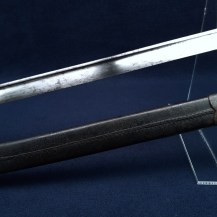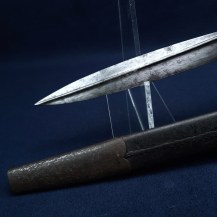British c1860 Volunteer Lancaster Bayonet
Unfullered pipeback blade with quill point, steel cross hilt with straight lower quillon with round forward-swept finial, and upper quillon projecting from the muzzle ring. Grip slabs of pressed black leather over wood, secured to the exposed tang with four rivets, one of which secures the external leaf spring which actuates the locking catch. Black leather scabbard with steel throat piece with oval frog stud and steel chape piece. Blade 58.9cm (~23 3/16 inches) in length, the bayonet 72.4cm (28½ inches) overall, muzzle ring diameter 20mm.
The blade is stamped at the ricasso on one side with the maker’s mark ‘CHAVASSE’, indicating manufacture by Chavasse & Co, Birmingham. The pommel is stamped with the number ‘208’, probably a rack or weapon number.
The Lancaster carbine was adopted by the Royal Sappers and Miners (the precursor to the Royal Engineers) in 1855, and came with a bayonet that was unusual for British Army issue, as it used brass for its hilt, pommel and scabbard fittings and had a conspicuously long pipeback blade. Pipeback blades for swords had fallen out of usage on British swords in the 1840s: while they were intended to be stiff in the thrust with a durable point, they were difficult to forge, easily bent and the cutting edge was so thin as to be fragile. The design might have fared better on a bayonet for which thrusting was paramount, and the shorter blade was less likely to flex, but fullered blades were the norm and the Lancaster would be the only British pipeback bayonet.
While its looks were striking on parade, the Lancaster bayonet was fragile, requiring more frequent repairs than other models. Despite this issue, sheer decorative appeal meant that the bayonets outlasted the carbines they were made for, being repurposed as parade sidearms for the Royal Army Medical Corps and remaining in service into the early 20th century.
Shortly after the Lancaster’s introduction, growing tensions in Europe raised concerns about Britain’s vulnerability to potential invasion. To bolster national defenses the War Office sanctioned the establishment of ‘Volunteer Corps’ in 1859. These units were somewhat a reinvention of the militia – non-professional soldiers who were expected to provide their own uniform and equipment, train at regular intervals and be ready for mobilisation in case of invasion. Providing their own equipment extended to arms too – some volunteer rifle units were provided with Army surplus but many instead pooled money and purchased weaponry from the commercial market.
Volunteer rifle units generally purchased carbines wherever possible, and one option for a bayonet to pair with these was the Lancaster. Its looks may have appealed to volunteer soldiers, or its potential to double as a bayonet and a sidearm. Commercial versions differed from the service model: they usually had steel components instead of brass, and a different scabbard closer to that of the contemporary cutlass bayonets. See British & Commonwealth Bayonets by Skennerton, p123.
These were not necessarily fitted to Lancaster carbines – each bayonet would have been hand-fitted and this may have been to the Enfield short rifles or carbines, of which there were multiple models.
The blade is unsharpened with no nicks to its edge. Some grinding and polishing marks to the blade, with some spots of patination, some frosting at the hilt end, areas of moderate pitting along the spine and small spots of heavy pitting on the flat of the blade in the pipeback section, some of these contacting the edge. The hilt, pommel, rivets and exposed tang have heavy dark patination and speckled light pitting, moderate pitting to the muzzle ring and upper quillon. The locking button functions well. The leather grips are very good with no apparent wear to the knurling, beside some surface rubbing at the pommel end. One small dent to the exposed tang.
The scabbard leather has some surface rubbing and flaking but is generally strong with all of its stitching intact, able to support its own weight. The scabbard throat and chape pieces are heavily patinated with peppered heavy pitting, some small dents to the chape piece which do not interfere with sheathing and drawing.













